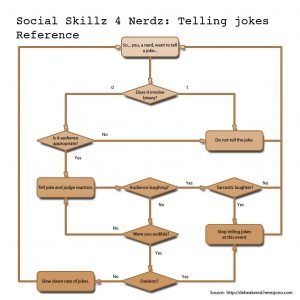Are you the kind of nerd that is forced to interact with “normal” people? Maybe it’s your boss. Or maybe it’s the postal worker from whom you pick up your Amazon deliveries. Whatever nerve-wracking situations you find yourself in, this guide will help you navigate the treacherous waters known as “social interaction” (colloquially known as “talking to people”) and help you pass an in-real-life Turing test like a ninja, fooling people into thinking you are human rather than a glasses-wearing inhabitant of uncanny valley.
This week’s topic is humour; specifically, how to handle situations where your joke has failed — but more on that later. And in case you’re looking at this post and thinking “TLDR“, I’ve included a handy summary flowchart at the end of this post. I will start with the premise that you do have an idea as to what humour is. After all, you have a large collection of jokes such as “there are 10 types of people in this world: those that know binary and those that don’t” and “2B OR NOT 2B = FF“. This brings us to our first point.
Binary humour is never funny
That’s right. Binary jokes are !funny. See? By now, your inquisitive nerd brain is probably demanding an explanation. Well, I’m glad you asked. This segues nicely into point number two…
Most people don’t share your sense of humour
As much as researchers have tried to convince people that “collywobbles”, “canoodles”, and “velociraptor” are amongst the funniest words in the English language, there is nothing inherently funny about a joke. More important than content and deliver is your audience.
This is key.
By all means, keep sharing the latest memes with your World of Warcraft guildies but, please, keep your ![]() and “1 + 1 =3, for sufficiently large one’s” jokes to yourself if you find yourself in a social gathering (conferences don’t count) or pub. This can lead to a quick trip to Wedgietown, population: you.
and “1 + 1 =3, for sufficiently large one’s” jokes to yourself if you find yourself in a social gathering (conferences don’t count) or pub. This can lead to a quick trip to Wedgietown, population: you.
Keeping these two things in mind is no guarantee your jokes will be funny to your audience. For the nerd’s nerd, the odds of telling a joke that will be well-received will still remain far below chance. Therefore, it is important that you be able to recognize what to do when your joke has flubbed. To do this, you will need to pay attention to other people’s reactions. Don’t worry; eye-contact will not be involved.
A joke that needs to be explained is probably not funny
If you are able to recognize signs of incomprehension (e.g., a blank stare) and find yourself with the urge to explain a joke, stop. If you just dropped a pun, avoid saying “get it?” This only draws attention to the fact that your pun failed.
Say what?
Unless you are prone to mumbling, any apparent requests to repeat yourself should be interpreted as incomprehension. This is not the time to explain your joke. See previous point.
You or your jokes are called corny
They mean it. You screwed up big time. Social etiquette dictates that one should not tell someone this. Therefore, you must have bored someone quite a bit for that person to break social conventions. Now is not the time to pull out puns from your a-maize-ing stash. Your audience is already suffering.
“Ha. Ha. That’s so funny.”
This tip is for advanced audiences only. The trick to this one is recognizing sarcasm. ((This is where someone says something and means the opposite.)) If the laugh surrounding “that’s so funny” is continuous and protracted (≥3 seconds), you are probably okay. Long gaps between laughs indicate sarcasm. This is the verbal equivalent of a slow clap. Further, if the variation in pitch in the sentence is virtually non-existent or deviates much more than usual, this is the IRL equivalent of the ⸮ irony mark or <sarcasm> tag. ((This tip applies in many situations although notable exceptions include when someone is screaming or singing. Bonus tip: if someone’s singing sounds like screaming, it is best not to draw attention to the fact.)) If you are still unsure, you may form the null hypothesis that sarcasm was intended and execute one test joke to attempt to invalidate it. Any response other than non-sarcastic laughter (see above) fails to disconfirm H0 and you should take this as strong evidence that your joke failed.
What to do when your joke has failed
Drop it. Telling it more than once does not make it funnier (exception: see technique used in Family Guy; this is not an endorsement of the show, however). If you encounter resistance (for example, social conventions are broken to tell you how bad your jokes are), you should save your brilliant attempts at humour for another social event. Say, with your D&D buddies. If light resistance is encountered (e.g., blank stares), proceed with caution; resist the urge to tell all but the best jokes until your success rate is approximately 80%.
Final note: Under no circumstances should you defend your jokes or sense of humour. That is, do not say things like, “Don’t you get it? She said plus a constant! But my thesis advisor thought it was hilarious!”
That’s it for this first instalment of Social Skillz 4 N3rdz. And, as promised, a handy flowchart for reference. This is SS4N rendering a socially appropriate sign-off that does not speak to the likelihood of one interlocutor making an ocular impression on the other in the (near) future: See you later!

